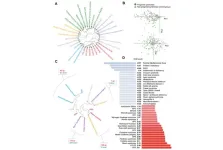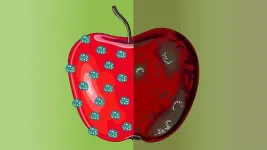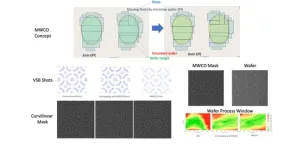(Press-News.org) Medical University of South Carolina scientists report in Neuron that they have uncovered a way to restore an opioid-weakened brain pathway in a preclinical model.
With funding from the National Institute on Drug Abuse, part of the National Institutes of Health, the MUSC research team, led by neuroscientist James Otis, Ph.D., used advanced neuroscience tools to return a pathway between the thalamus and basal ganglia to healthy functioning in mice. As a result, this restoration prevented mice that were opioid-dependent from seeking or self-administering heroin. Results also suggested that sustained opioid use was the cause of this weakened pathway, rather than being caused by it.
“Our study is the first showing that this pathway, associated with the capability of stopping behavior, can be ‘rescued’ after being weakened by opioid use,” Otis said.
Otis was surprised that not only could this brain pathway be returned to healthy functioning, but that its recovery prevented relapse.
“When we brought this brain circuit back to what we think of as a healthy state, we were excited to see that it could inhibit behaviors such as relapse,” said Otis.
This pathway of neurons identified by Otis’ team is critical for controlling or stopping behavior – also referred to as behavioral control. Difficulty stopping is a hallmark feature of many neuropsychiatric disorders, including substance use disorders. The capacity to stop is a critical skill in recovering from drug dependence and avoiding relapse.
Studies have shown that people with substance use disorders find it more difficult to stop behavior, he explained. In previous studies, they took longer to pause behavioral tasks than those without a history of substance use.
Difficulty stopping is a key reason why people with substance use disorders may continue to use substances despite negative consequences or despite their desire to stop. Restoring behavioral control could improve their ability to stop such behaviors and remain drug abstinent.
Researchers have identified pathways in the brain that influence our capacity to stop different behaviors. For example, our brains can stop motor movement when two regions of the brain – the prefrontal cortex and basal ganglia – talk to one another. The prefrontal cortex makes the decision to stop and sends this message to the basal ganglia. The basal ganglia then prevents the movement. The communication between these areas of the brain has been shown to be disrupted in people with substance use disorders, helping to explain the challenges they face with this skill.
Expanding on this research, Otis and his team identified a new pathway of neurons in mice involved with stopping behavior. In a previous study, his team found that this series of neurons, beginning in the thalamus, similarly communicated with the basal ganglia to control movement.
This study reported in Neuron helps to resolve a long-standing chicken-or-egg debate about the relationship between difficulty stopping behavior and substance use disorder. Does an impaired capacity to stop increase the likelihood that someone will later develop a substance use disorder? Or does repeated drug use weaken the parts of the brain involved with this ability?
“We wanted to know more about how opioid use influences these neurons, or if instead these neurons are already impaired in those who are vulnerable to future opioid addiction,” Otis explained.
Findings from this research strongly suggest that the weakening of this pathway happens because of opioid use, rather than being a cause of opioid use. After two weeks of opioid use by the mice, Otis and his team observed that this pathway became half as strong as it was prior to drug use.
The next step is to see if these results can be repeated with substances such as alcohol, methamphetamine, amphetamine and cocaine.
The experimental techniques used to restore this brain circuit in a preclinical model are not suitable for human studies. However, Otis can envision that future drug treatments could rehabilitate brain functioning associated with drug use.
“The goal of addiction treatment should be to recover healthy brain circuitry, rather than just prevent relapse or prevent the symptoms of addiction,” said Otis.
# # #
The content in the underlying article is solely the responsibility of the authors and does not necessarily represent the official views of the National Institutes of Health.
About Medical University of South Carolina
Founded in 1824 in Charleston, MUSC is the state’s only comprehensive academic health system, with a unique mission to preserve and optimize human life in South Carolina through education, research and patient care. Each year, MUSC educates more than 3,200 students in six colleges – Dental Medicine, Graduate Studies, Health Professions, Medicine, Nursing and Pharmacy – and trains more than 900 residents and fellows in its health system. MUSC brought in more than $300 million in research funds in fiscal year 2023, leading the state overall in research funding. MUSC also leads the state in federal and National Institutes of Health funding. For information on academic programs, visit musc.edu.
As the health care system of the Medical University of South Carolina, MUSC Health is dedicated to delivering the highest-quality and safest patient care while educating and training generations of outstanding health care providers and leaders to serve the people of South Carolina and beyond. Patient care is provided at 16 hospitals (includes owned or governing interest), with approximately 2,700 beds and four additional hospital locations in development, more than 350 telehealth sites and nearly 750 care locations situated in all regions of South Carolina. In 2023, for the ninth consecutive year, U.S. News & World Report named MUSC Health University Medical Center in Charleston the No. 1 hospital in South Carolina. To learn more about clinical patient services, visit muschealth.org.
MUSC has a total enterprise annual operating budget of $5.9 billion. The nearly 26,000 MUSC family members include world-class faculty, physicians, specialty providers, scientists, students, affiliates and care team members who deliver groundbreaking education, research, and patient care.
END
Preventing relapse by restoring an opioid-weakened brain pathway governing behavior
In a preclinical model, Medical University of South Carolina researchers restore an opioid-weakened brain pathway that controls behavior, thereby preventing relapse.
2024-02-21
ELSE PRESS RELEASES FROM THIS DATE:
Water quality monitor, locust-inspired electronic nose under development
2024-02-21
By Beth Miller
Two teams of engineers led by faculty in the McKelvey School of Engineering at Washington University in St. Louis will work toward developing products to monitor drinking water quality and to detect explosives with an electronic nose with one-year, $650,000 Convergence Accelerator Phase 1 grants from the National Science Foundation (NSF).
Barani Raman, professor of biomedical engineering, and Daniel Giammar, the Walter E. Browne Professor of Environmental Engineering, will lead teams of researchers from Washington University and other institutions and entities funded under the NSF’s Convergence Accelerator program, designed to address national-scale ...
Child tax credits provided significant relief to families experiencing economic shocks during COVID
2024-02-21
Contact:
Jillian McKoy, jpmckoy@bu.edu
Michael Saunders, msaunder@bu.edu
##
As a proposal to reinstate expanded Child Tax Credits (CTC) in the United States awaits a vote in the Senate, a new study led by Boston University School of Public Health (BUSPH) researchers reveals that the now-expired 2021 CTC expansion benefitted families experiencing financial setbacks due to health or employment challenges spurred by the COVID-19 pandemic.
Published in the journal Health Affairs Scholar, the study found that monthly advance payments included in the 2021 CTC ...
Plasma scientists develop computer programs that could reduce the cost of microchips and stimulate American manufacturing
2024-02-21
Fashioned from the same element found in sand and covered by intricate patterns, microchips power smartphones, augment appliances and aid the operation of cars and airplanes. Now, scientists at the U.S. Department of Energy’s (DOE) Princeton Plasma Physics Laboratory (PPPL) are developing computer simulation codes that will outperform current simulation techniques and aid the production of microchips using plasma, the electrically charged state of matter also used in fusion research. These codes could help increase the efficiency of the manufacturing process and potentially stimulate ...
Novel combination therapy offers promising results for treatment-refractory hepatoblastoma
2024-02-21
Hepatoblastoma (HB) is the most common liver cancer in children. Researchers and physicians in the field are concerned because in the last decade HB has been rising rapidly worldwide and has seen the most rapid increase among all pediatric solid tumors.
A team led by researchers at Baylor College of Medicine has been working on improving therapies for this devastating disease. They recently reported in the Journal of Hepatology a novel treatment strategy that produced encouraging results in animal models.
“High-risk disease leads to high rates of relapse and mortality,” said first author Dr. Andrés F. Espinoza, general ...
New study: Defining the progeria phenome
2024-02-21
“In sum, we have defined what a premature aging disease is and developed tools to allow diagnostics of patients and disease population.”
BUFFALO, NY- February 20, 2024 – A new research paper was published in Aging (listed by MEDLINE/PubMed as "Aging (Albany NY)" and "Aging-US" by Web of Science) Volume 16, Issue 3, entitled, “Defining the progeria phenome.”
Progeroid disorders are a heterogenous group of rare and complex hereditary syndromes presenting with pleiotropic phenotypes associated with normal aging. Due to the ...
Low oxygen in lakes may breathe new life into conservation efforts for water quality
2024-02-21
Abigail Lewis traveled all across the United States for college and graduate school, and she ended up researching lakes in her own hometown.
For one of her graduate research projects, Lewis analyzed 656 lakes across five continents with an international research team. The lakes in her hometown of Waukesha, Wisconsin, were among those included.
“To look back and pull together these two parts of my life has been really satisfying,” said Lewis, who will earn her Ph.D. in biological sciences this spring.
In a paper recently published in Global Change Biology, ...
Engineering a coating for disease-free produce
2024-02-21
Dr. Mustafa Akbulut, professor of chemical engineering, has teamed up with horticultural science professor Luis Cisneros-Zevallos to engineer longer-lasting, bacteria-free produce.
According to Akbulut’s recent publication in Current Research in Food Science, the global fruit and vegetable market loses over 50% of agricultural fruit production during various stages of produce handling and post-harvest treatments.
Many fruits and vegetables already have a layer of food-grade wax that is applied for cosmetic reasons and to prevent water loss. Akbulut’s research combines such wax with nano-encapsulated cinnamon-bark ...
Ochsner Children’s Hospital advocates to close the gap in pediatric heart care
2024-02-21
NEW ORLEANS, LA - Ochsner Children's Hospital, ranked among the top hospitals in the nation for pediatric cardiology and congenital heart surgery, is raising awareness of the need for more pediatric-specific heart devices. As the only pediatric heart transplant program in Louisiana and the only program in the state to offer advanced mechanical support options for pediatric cardiology patients, Ochsner Children’s Hospital is committed to advocating for additional medical devices to enhance its high-quality care to pediatric patients ...
Cobalt-free electrodes achieved with nickel ions
2024-02-20
Many electric vehicles are powered by lithium-ion batteries that rely on cobalt — a scarce, expensive metal with high environmental and social costs. A team of researchers from Japanese and French universities have now developed a practical nickel-based electrode material that opens new avenues to cobalt-free batteries for electric vehicles.
The researchers detailed their findings in a study published on Jan. 15 in the journal Energy Storage Materials.
“There is an undeniable need for cobalt-free, high-energy electrode materials for lithium-ion ...
Throwing lithography a curve
2024-02-20
At the heart of advancing semiconductor chip technology lies a critical challenge: creating smaller, more efficient electronic components. This challenge is particularly evident in the field of lithography, the process used to create intricate patterns on semiconductor materials (called wafers) for the production of chips. Lithography uses a kind of template, called a photomask — or just mask — for creating patterns on semiconductor wafers. The industry is always looking for methods that improve resolution and manufacturability for both masks and ...
LAST 30 PRESS RELEASES:
Exploring why adapting to the environment is more difficult as people age
Society for Laboratory Automation and Screening welcomes new scientific director: Madeline M. Farley, Ph.D.
Austrian cow shows first case of flexible, multi-purpose tool use in cattle
Human nasal passages defend against the common cold and help determine how sick we get
Research alert: Spreading drug costs over the year may ease financial burden for Medicare cancer patients
Hospital partnership improves follow up scans, decreases long term risk after aortic repair
Layered hydrogen silicane for safe, lightweight, and energy-efficient hydrogen carrier
Observing positronium beam as a quantum matter wave for the first time
IEEE study investigates the effects of pointing error on quantum key distribution systems
Analyzing submerged fault structures to predict future earthquakes in Türkiye
Quantum ‘alchemy’ made feasible with excitons
‘Revoice’ device gives stroke patients their voice back
USF-led study: AI helps reveal global surge in floating algae
New method predicts asthma attacks up to five years in advance
Researchers publish first ever structural engineering manual for bamboo
National poll: Less than half of parents say swearing is never OK for kids
Decades of suffering: Long-term mental health outcomes of Kurdish chemical gas attacks
Interactional dynamics of self-assessment and advice in peer reflection on microteaching
When aging affects the young: Revealing the weight of caregiving on teenagers
Can Canada’s health systems handle increased demand during FIFA World Cup?
Autistic and non-autistic faces may “speak a different language” when expressing emotion
No clear evidence that cannabis-based medicines relieve chronic nerve pain
Pioneering second-order nonlinear vibrational nanoscopy for interfacial molecular systems beyond the diffraction limit
Bottleneck in hydrogen distribution jeopardises billions in clean energy
Lung cancer death rates among women in Europe are finally levelling off
Scientists trace microplastics in fertilizer from fields to the beach
The Lancet Obstetrics, Gynecology, & Women’s Health: Taking paracetamol during pregnancy does not increase risk of autism, ADHD or intellectual disabilities, confirms new gold-standard evidence review
Taking paracetamol during pregnancy does not increase risk of autism, ADHD or intellectual disabilities
Harm reduction vending machines in New York State expand access to overdose treatment and drug test strips, UB studies confirm
University of Phoenix releases white paper on Credit for Prior Learning as a catalyst for internal mobility and retention
[Press-News.org] Preventing relapse by restoring an opioid-weakened brain pathway governing behaviorIn a preclinical model, Medical University of South Carolina researchers restore an opioid-weakened brain pathway that controls behavior, thereby preventing relapse.





